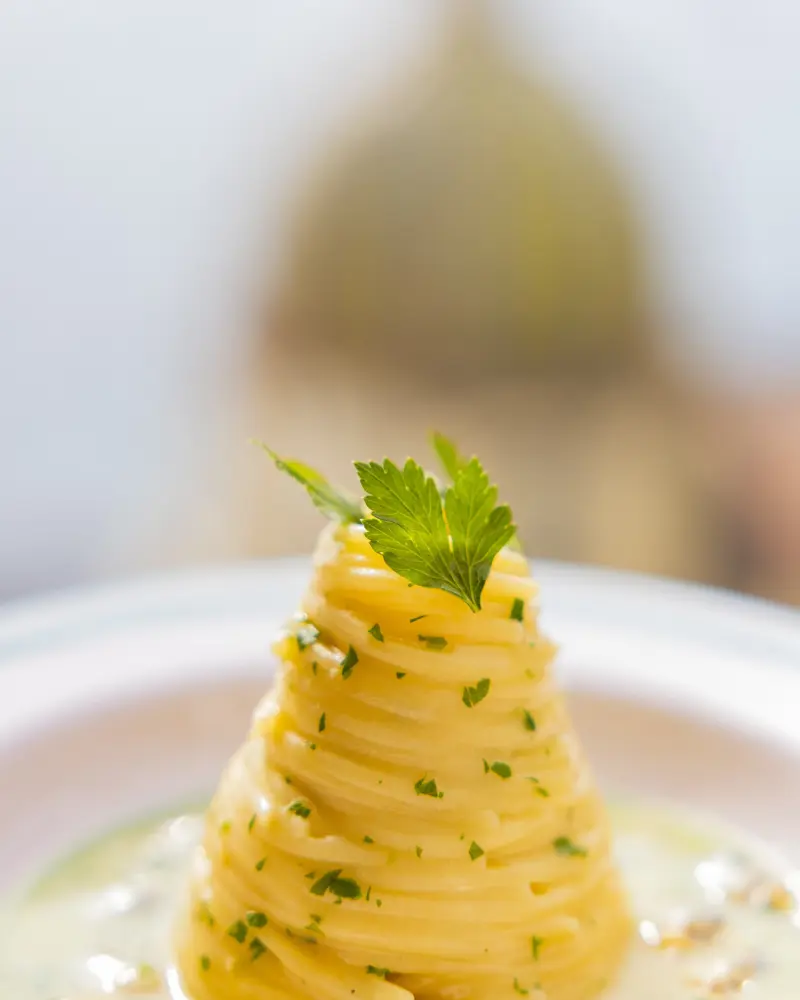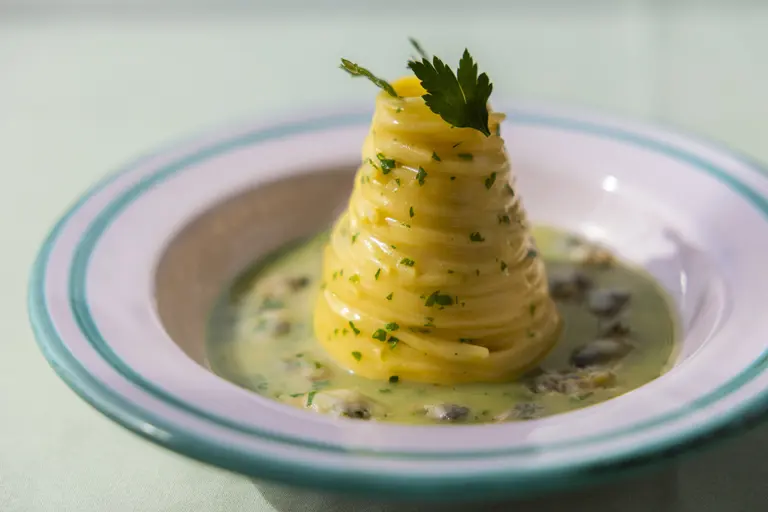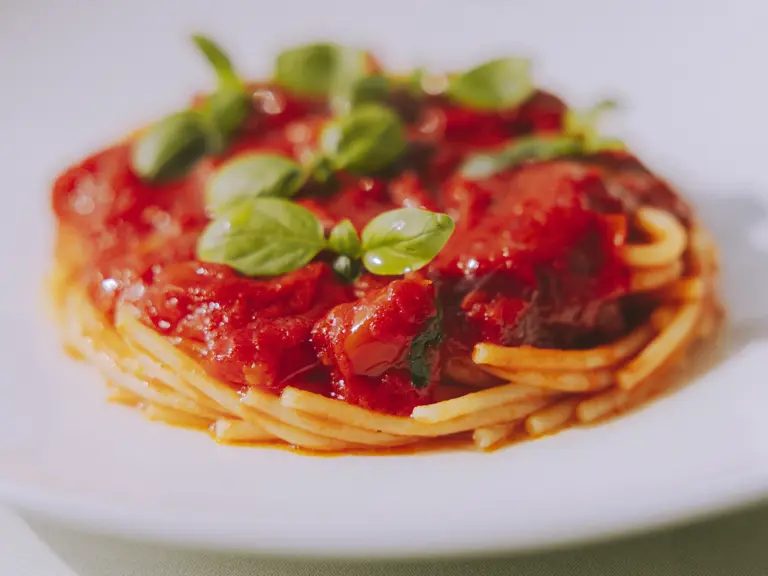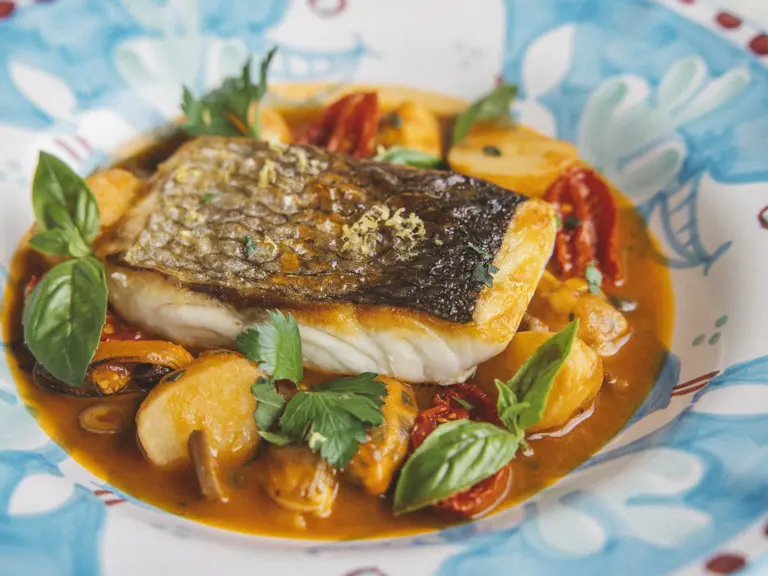RECIPE: SPAGHETTI ALLE VONGOLE
26.09.2025 RECIPES
Notice that word ‘apparently’ up there? As Le Sirenuse’s executive chef Gennaro Russo always says: “Simple doesn’t necessarily mean ‘easy’.” True simplicity calls for attention, curation and experience.
The secret of this recipe’s success lies in what Italians call the mantecatura of the pasta. It’s not enough to cook the spaghetti, cook the clams, and add the latter to the former. What you’re aiming for is to cover the pasta in a silky, creamy sauce that is not prepared separately but derives from the cooking process itself, from a combination of the pasta starch, the olive oil and the vongole juices.
It helps, of course, to have absolutely top-drawer ingredients. On Italy’s Mediterranean shores, the variety of clams to go for is the large and flavoursome vongole veraci – though there is a vocal minority that prefers the smaller clams known as lupini. Be aware that if you choose the latter, you or your guests will have a lot more shell-opening work ahead of you, as you will need at least double the number. Do not, under any circumstances, consider canned or frozen vongole.
Gennaro will always opt for spaghetti from one or other of the master pasta-makers based in the town of Gragnano, south of Naples. Pastificio dei Campi, Gentile and Gerardo di Nola are all reputable artisanal firms, but other excellences are available. The size of spaghetti is a matter of personal taste; Gennaro like to use a slightly thicker variety to better absorb the sauce.
SPAGHETTI ALLE VONGOLE
serves four
370g (13oz) spaghetti
1kg (2.2lb) vongole veraci (fresh shell-on clams)
3 cloves of garlic
A bunch of parsley, destemmed and chopped
Extra-virgin olive oil

First, some time before, you’ll need to clean and ‘purge’ the clams so you or your guests don’t find yourselves crunching on any sand that has entered the shells. Begin by rinsing them well under running water. Remove any obvious debris with a rough brush, and check for cracked or broken shells, which should be immediately discarded. (If any shells are slightly open, tap them; if they close, they’re fine, if they stay open, chuck them out). Then place the clams in a bowl of salted water: calculate a third of a cup of salt per gallon of water, or 80g for 2 litres. You don’t need to do this for hours, taking them in and out of the fridge, as some food writers suggest. Half an hour sitting in a bowl of salted water in your kitchen will be fine. Once they’re purged, rinse and dry them with a tea towel.
Set the pasta water on to boil. Be generous: use at least 1 litre (4 cups) of water per 100g (3.5 oz) of pasta. Salt at 1%, so aim for 2 tablespoons per 4 litres. Check the packet for the recommended cooking time, bearing in mind that once you put the clams in the pan, they will only take six to seven minutes – but you will need longer if you’re planning to deshell them before serving. Don’t forget to reserve a cup of the cooking water before you drain the pasta.
Put a generous glug (four or five tablespoons) of olive oil in a wide, heavy-bottomed pan and place it on a medium flame. Once the oil is hot but not steaming, put in the peeled and lightly crushed garlic cloves, and toss until they take on colour. Once they’re golden brown, remove.
At this point, add the vongole and one cup of water, raise the heat to lively, and cover the pan. It shouldn’t take long for the clams to open, but don’t peek until five minutes have gone by. The trick is not to boil away the juice, so be ruthless regarding any shells that haven’t opened. You can close the lid again and raise the heat a little for another couple of minutes, but any clams that stay stubbornly shut after this should be discarded.
Now is when you decide whether you’re going to make things easy for your guests by deshelling the clams yourself (an empty bivalve clamshell makes a good extractor, or you can use your thumb), or whether it’s more fun to serve the clams on the pasta shell-on, accompanied by a finger bowl. You could even do half and half…
Add the drained spaghetti to the vongole pan, glug in a little more olive oil to taste, sprinkle in the chopped parsley, reduce the heat a little, and stir for a minute or so to amalgamate the juices and the pasta starch. If the pasta is good enough, Gennaro counsels, and if you were careful not to simmer away the vongole juices, you shouldn’t need to add any of the pasta water you kept aside at this stage, but it’s there if you need it. If the pasta looks a little dry, add a little at a time until it’s coated with a creamy emulsion.
Serve fancy, by twirling with a fork into cones, or serve plain: it’s up to you. It tastes just as good either way.
Photos © Roberto Salomone
Le Sirenuse Newsletter
Stay up to date
Sign up to our newsletter for regular updates on Amalfi Coast stories, events, recipes and glorious sunsets



